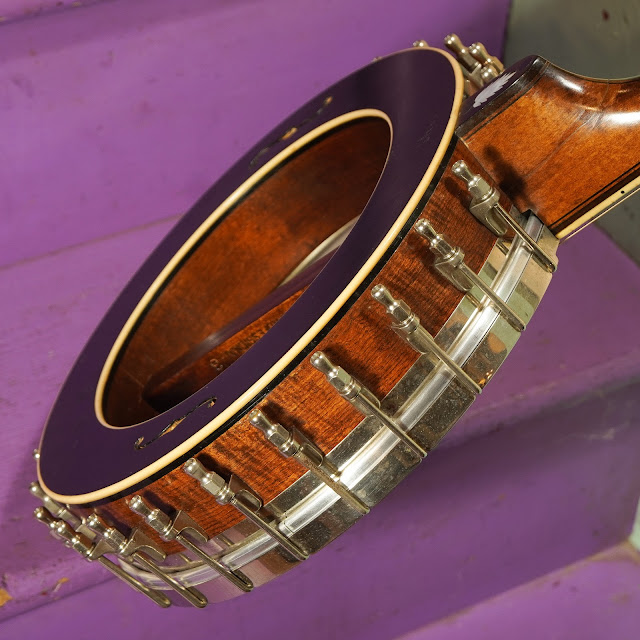1924 Bacon Professional 3 Tenor Banjo
1924 was early days at the Groton, CT factory for Bacon. Just a few years prior their line was made by Lange for the brand. This is an actual Bacon, though, and features the "Professional" rim design -- an outer, multi-ply rim with tonering and an inner, "reflection" rim designed to give the instrument its own secondary soundbox.
Does it work? Well, yes! I think what this does for the instrument is create an effect a bit like having a resonator on the back but without the resonator's bulk and with a "side-spread" to the sound that's resonator-like but not nearly as directional. So, in effect, it sounds louder than a similarly-equipped openback but it doesn't have the zippy, laser-focus snap that you'd expect a resonator instrument to have.
This has a "hoop-in-sleeve" tonering design similar to a Vega Little Wonder tonering, though said ring on this guy is larger in diameter and so a bit more massive. As a result, it sounds sort-of like a Little Wonder instrument but with more volume, sparkle, and pop. It's almost Gibson-sounding, in a way -- you know, that upper-mids, woody "pop" sound? It's a good sound.
Lasty, I'd just like to point out that the "professional" in the name applies to the instrument's build quality, too. It's high-spec, has nice hardware, pretty inlay, binding and "strapping" all over the place, and a great look.
Post-repairs it plays spot-on and is ready to go for the long haul.
Repairs included: a fret level/dress, new Remo Renaissance synthetic head, cleaning, and setup.
Rim wood: multi-ply maple
Tonering: hoop-in-sleeve (Little Wonder-style)
Bridge: vintage Grover 2-foot maple
Fretboard: ebonized wood
Neck wood: maple, 2-piece
Action height at 12th fret: 1/16" overall (fast, spot-on)
String gauges: 32w, 20w, 13, 9 for CGDA tuning
Neck shape: medium C/V
Board radius: flat
Neck relief: straight
Fret style: smaller/lower
Scale length: 20 3/4"
Nut width: 1 1/8"
Head diameter: 11”
Depth overall at rim: 3"
Weight: 6 lbs 3 oz
Condition notes: it's fairly clean throughout except for an old split heel repair. You can see it in the pics -- it was repaired some time ago and has been stable in service. There are apparently two plugs/reinforcements installed through the heel cap and into the heel as well. I applaud that extra reinforcement aside from just the normal glue-up. The hardware appears to be all-original save a missing tailpiece cover. The original head is stowed in the case. The bridge is likely a replacement. This banjo also has its original friction pegs (spring-loaded for easier turning, though) at the headstock. Folks used to 1:1 tuning will have no issue with them but I always like to suggest swapping to geared banjo pegs for ease of use for day-to-day playing.
It comes with: an original hard case in decent shape.



























Comments